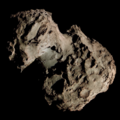P/2016 P5 (COIAS)
Appearance
 Precovery image of Comet COIAS (center) taken from the Subaru Telescope on 3 July 2016 | |
| Discovery[1] | |
|---|---|
| Discovered by | Seitaro Urakawa H. Fukuyama |
| Discovery site | Subaru–MKO Come On! Impacting ASteroids (COIAS) |
| Discovery date | 1 August 2016 |
| Orbital characteristics[3] | |
| Epoch | 1 December 2015 (JD 2457357.5) |
| Observation arc | 18.83 years |
| Earliest precovery date | 23 June 2004 |
| Number of observations | 58 |
| Aphelion | 4.979 AU |
| Perihelion | 4.426 AU |
| Semi-major axis | 4.703 AU |
| Eccentricity | 0.05885 |
| Orbital period | 10.198 years |
| Inclination | 7.036° |
| 185.48° | |
| Argument of periapsis | 33.632° |
| Last perihelion | 29 May 2023[2] |
| Next perihelion | c. 2033 |
| TJupiter | 2.990 |
| Earth MOID | 3.422 AU |
| Jupiter MOID | 0.001 AU |
| Comet total magnitude (M1) | 8.0 |
P/2016 P5 (COIAS) is a Jupiter-family comet with a 10-year orbit around the Sun. Its discovery was announced on 21 March 2025, when cometary activity was spotted on an asteroidal object that was photographed by the Subaru Telescope in 2016.[1]
References
[edit]- ^ a b D. W. Green (21 March 2025). "Comet P/2016 P5 (COIAS)". Central Bureau for Astronomical Telegrams. 5529.
- ^ S. Yoshida. "P/2016 P5 (COIAS)". www.aerith.net. Retrieved 8 May 2025.
- ^ "P/2016 P5 (COIAS) – JPL Small-Body Database Lookup". ssd.jpl.nasa.gov. Jet Propulsion Laboratory. Retrieved 8 May 2025.
External links
[edit]- P/2016 P5 at the JPL Small-Body Database


